Leadership in Contemporary Organisations: A Personal Leadership Vision
VerifiedAdded on 2023/01/10
|18
|4824
|2
Essay
AI Summary
This essay delves into the multifaceted realm of leadership, examining various leadership theories such as trait theory, behavioral theory, situational theory, and transactional/transformational leadership. It explores the evolution of these theories, highlighting their strengths and weaknesses. The essay then focuses on transformational leadership, dissecting its core elements: idealized influence, inspirational motivation, intellectual stimulation, and individualized consideration. The author articulates a personal aspiration to become a transformational leader, detailing how these elements can be applied to bring about positive change within an organization. The essay also addresses the importance of follower involvement in the leadership process, emphasizing the need for followers to understand and embrace the benefits of transformational leadership. The discussion includes styles like the directive style, aiming to foster effective leadership dynamics.

Leadership 1
Leadership in Contemporary Organisations
Leadership in Contemporary Organisations
Paraphrase This Document
Need a fresh take? Get an instant paraphrase of this document with our AI Paraphraser
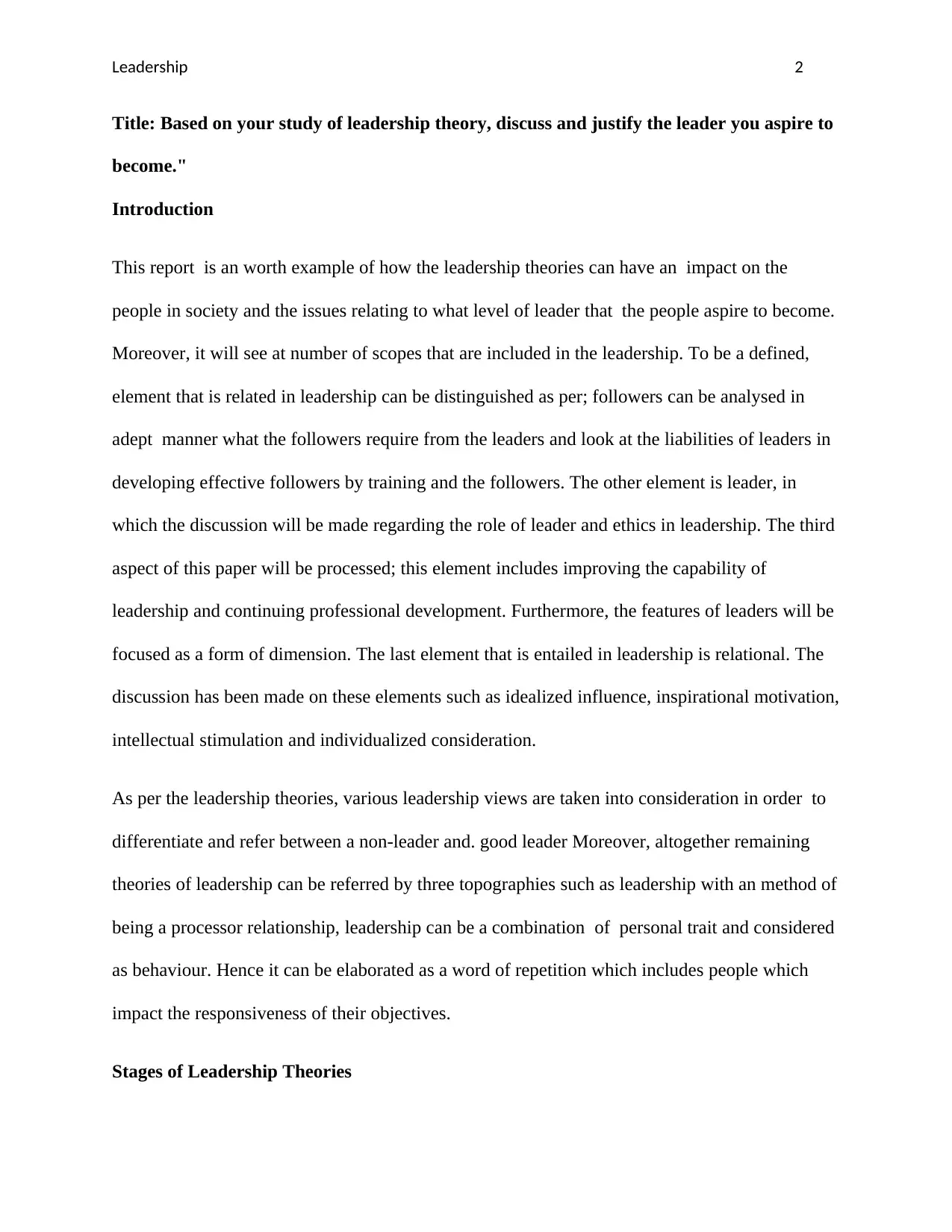
Leadership 2
Title: Based on your study of leadership theory, discuss and justify the leader you aspire to
become."
Introduction
This report is an worth example of how the leadership theories can have an impact on the
people in society and the issues relating to what level of leader that the people aspire to become.
Moreover, it will see at number of scopes that are included in the leadership. To be a defined,
element that is related in leadership can be distinguished as per; followers can be analysed in
adept manner what the followers require from the leaders and look at the liabilities of leaders in
developing effective followers by training and the followers. The other element is leader, in
which the discussion will be made regarding the role of leader and ethics in leadership. The third
aspect of this paper will be processed; this element includes improving the capability of
leadership and continuing professional development. Furthermore, the features of leaders will be
focused as a form of dimension. The last element that is entailed in leadership is relational. The
discussion has been made on these elements such as idealized influence, inspirational motivation,
intellectual stimulation and individualized consideration.
As per the leadership theories, various leadership views are taken into consideration in order to
differentiate and refer between a non-leader and. good leader Moreover, altogether remaining
theories of leadership can be referred by three topographies such as leadership with an method of
being a processor relationship, leadership can be a combination of personal trait and considered
as behaviour. Hence it can be elaborated as a word of repetition which includes people which
impact the responsiveness of their objectives.
Stages of Leadership Theories
Title: Based on your study of leadership theory, discuss and justify the leader you aspire to
become."
Introduction
This report is an worth example of how the leadership theories can have an impact on the
people in society and the issues relating to what level of leader that the people aspire to become.
Moreover, it will see at number of scopes that are included in the leadership. To be a defined,
element that is related in leadership can be distinguished as per; followers can be analysed in
adept manner what the followers require from the leaders and look at the liabilities of leaders in
developing effective followers by training and the followers. The other element is leader, in
which the discussion will be made regarding the role of leader and ethics in leadership. The third
aspect of this paper will be processed; this element includes improving the capability of
leadership and continuing professional development. Furthermore, the features of leaders will be
focused as a form of dimension. The last element that is entailed in leadership is relational. The
discussion has been made on these elements such as idealized influence, inspirational motivation,
intellectual stimulation and individualized consideration.
As per the leadership theories, various leadership views are taken into consideration in order to
differentiate and refer between a non-leader and. good leader Moreover, altogether remaining
theories of leadership can be referred by three topographies such as leadership with an method of
being a processor relationship, leadership can be a combination of personal trait and considered
as behaviour. Hence it can be elaborated as a word of repetition which includes people which
impact the responsiveness of their objectives.
Stages of Leadership Theories
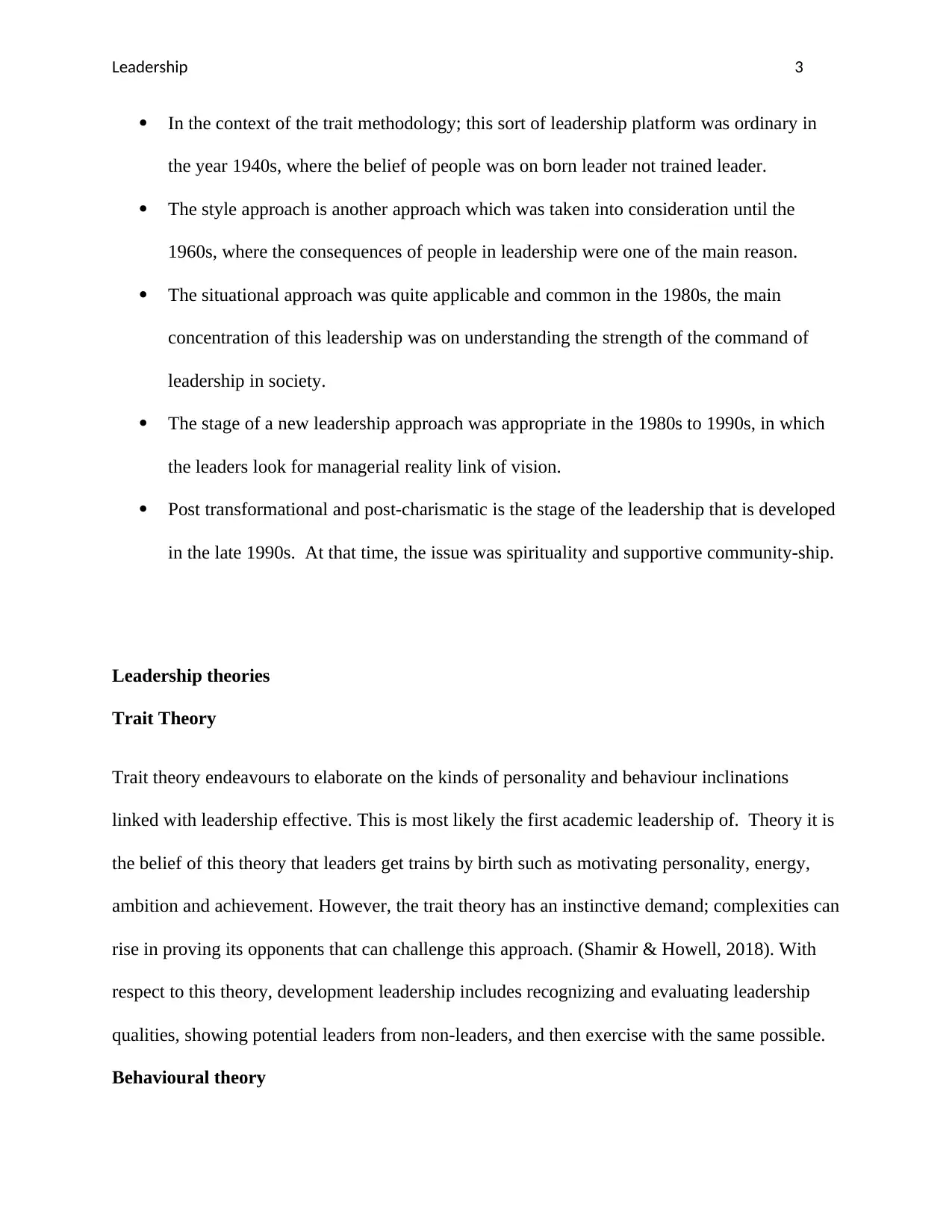
Leadership 3
In the context of the trait methodology; this sort of leadership platform was ordinary in
the year 1940s, where the belief of people was on born leader not trained leader.
The style approach is another approach which was taken into consideration until the
1960s, where the consequences of people in leadership were one of the main reason.
The situational approach was quite applicable and common in the 1980s, the main
concentration of this leadership was on understanding the strength of the command of
leadership in society.
The stage of a new leadership approach was appropriate in the 1980s to 1990s, in which
the leaders look for managerial reality link of vision.
Post transformational and post-charismatic is the stage of the leadership that is developed
in the late 1990s. At that time, the issue was spirituality and supportive community-ship.
Leadership theories
Trait Theory
Trait theory endeavours to elaborate on the kinds of personality and behaviour inclinations
linked with leadership effective. This is most likely the first academic leadership of. Theory it is
the belief of this theory that leaders get trains by birth such as motivating personality, energy,
ambition and achievement. However, the trait theory has an instinctive demand; complexities can
rise in proving its opponents that can challenge this approach. (Shamir & Howell, 2018). With
respect to this theory, development leadership includes recognizing and evaluating leadership
qualities, showing potential leaders from non-leaders, and then exercise with the same possible.
Behavioural theory
In the context of the trait methodology; this sort of leadership platform was ordinary in
the year 1940s, where the belief of people was on born leader not trained leader.
The style approach is another approach which was taken into consideration until the
1960s, where the consequences of people in leadership were one of the main reason.
The situational approach was quite applicable and common in the 1980s, the main
concentration of this leadership was on understanding the strength of the command of
leadership in society.
The stage of a new leadership approach was appropriate in the 1980s to 1990s, in which
the leaders look for managerial reality link of vision.
Post transformational and post-charismatic is the stage of the leadership that is developed
in the late 1990s. At that time, the issue was spirituality and supportive community-ship.
Leadership theories
Trait Theory
Trait theory endeavours to elaborate on the kinds of personality and behaviour inclinations
linked with leadership effective. This is most likely the first academic leadership of. Theory it is
the belief of this theory that leaders get trains by birth such as motivating personality, energy,
ambition and achievement. However, the trait theory has an instinctive demand; complexities can
rise in proving its opponents that can challenge this approach. (Shamir & Howell, 2018). With
respect to this theory, development leadership includes recognizing and evaluating leadership
qualities, showing potential leaders from non-leaders, and then exercise with the same possible.
Behavioural theory
⊘ This is a preview!⊘
Do you want full access?
Subscribe today to unlock all pages.

Trusted by 1+ million students worldwide
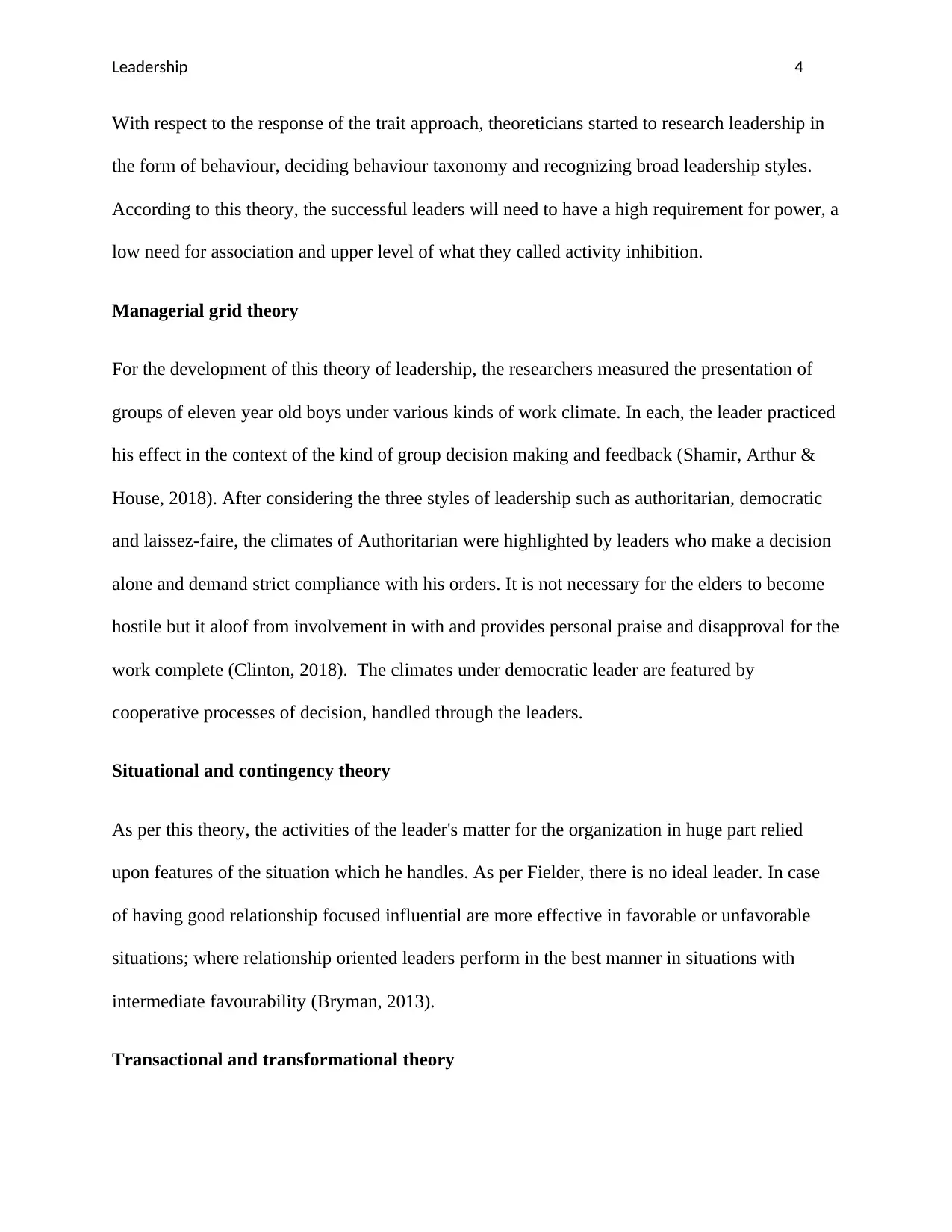
Leadership 4
With respect to the response of the trait approach, theoreticians started to research leadership in
the form of behaviour, deciding behaviour taxonomy and recognizing broad leadership styles.
According to this theory, the successful leaders will need to have a high requirement for power, a
low need for association and upper level of what they called activity inhibition.
Managerial grid theory
For the development of this theory of leadership, the researchers measured the presentation of
groups of eleven year old boys under various kinds of work climate. In each, the leader practiced
his effect in the context of the kind of group decision making and feedback (Shamir, Arthur &
House, 2018). After considering the three styles of leadership such as authoritarian, democratic
and laissez-faire, the climates of Authoritarian were highlighted by leaders who make a decision
alone and demand strict compliance with his orders. It is not necessary for the elders to become
hostile but it aloof from involvement in with and provides personal praise and disapproval for the
work complete (Clinton, 2018). The climates under democratic leader are featured by
cooperative processes of decision, handled through the leaders.
Situational and contingency theory
As per this theory, the activities of the leader's matter for the organization in huge part relied
upon features of the situation which he handles. As per Fielder, there is no ideal leader. In case
of having good relationship focused influential are more effective in favorable or unfavorable
situations; where relationship oriented leaders perform in the best manner in situations with
intermediate favourability (Bryman, 2013).
Transactional and transformational theory
With respect to the response of the trait approach, theoreticians started to research leadership in
the form of behaviour, deciding behaviour taxonomy and recognizing broad leadership styles.
According to this theory, the successful leaders will need to have a high requirement for power, a
low need for association and upper level of what they called activity inhibition.
Managerial grid theory
For the development of this theory of leadership, the researchers measured the presentation of
groups of eleven year old boys under various kinds of work climate. In each, the leader practiced
his effect in the context of the kind of group decision making and feedback (Shamir, Arthur &
House, 2018). After considering the three styles of leadership such as authoritarian, democratic
and laissez-faire, the climates of Authoritarian were highlighted by leaders who make a decision
alone and demand strict compliance with his orders. It is not necessary for the elders to become
hostile but it aloof from involvement in with and provides personal praise and disapproval for the
work complete (Clinton, 2018). The climates under democratic leader are featured by
cooperative processes of decision, handled through the leaders.
Situational and contingency theory
As per this theory, the activities of the leader's matter for the organization in huge part relied
upon features of the situation which he handles. As per Fielder, there is no ideal leader. In case
of having good relationship focused influential are more effective in favorable or unfavorable
situations; where relationship oriented leaders perform in the best manner in situations with
intermediate favourability (Bryman, 2013).
Transactional and transformational theory
Paraphrase This Document
Need a fresh take? Get an instant paraphrase of this document with our AI Paraphraser
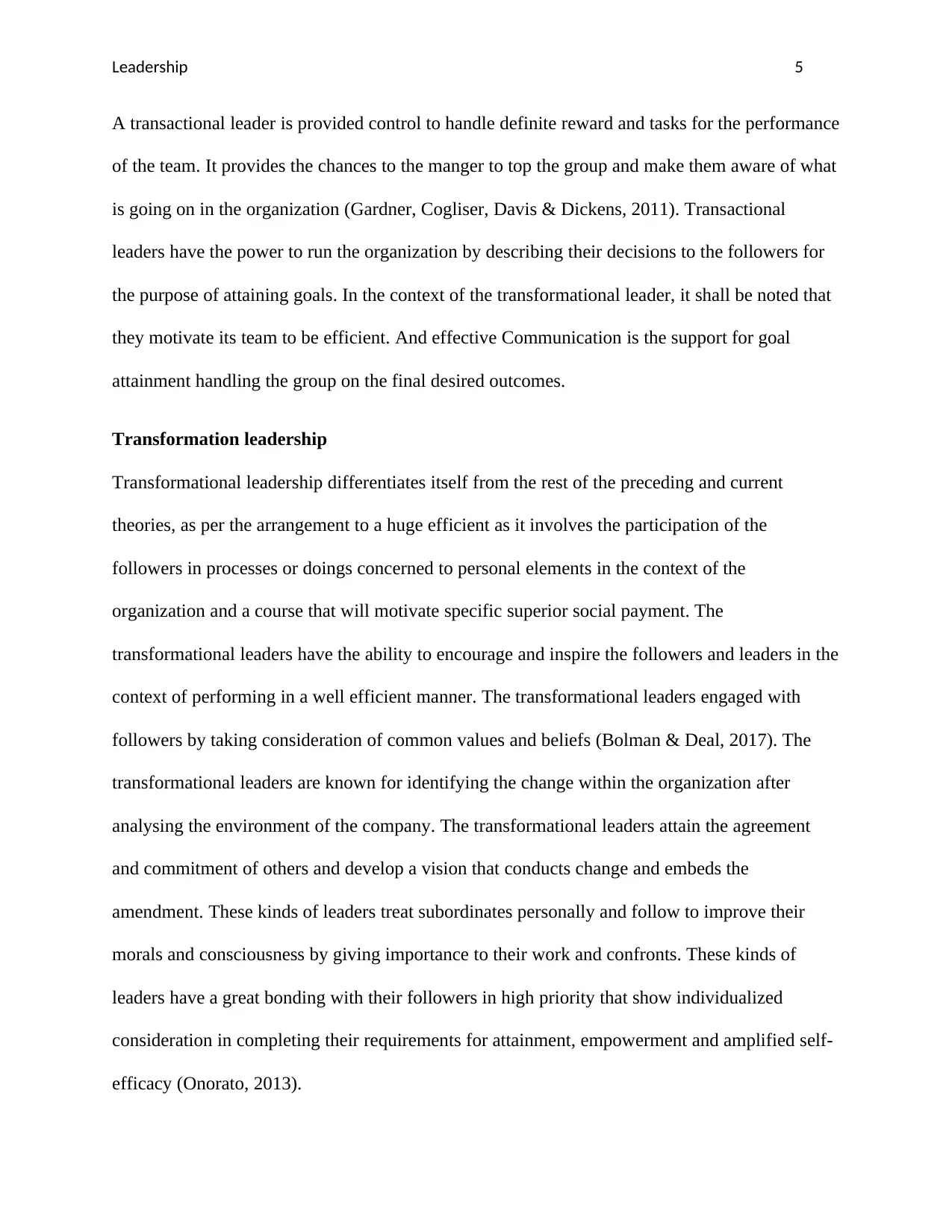
Leadership 5
A transactional leader is provided control to handle definite reward and tasks for the performance
of the team. It provides the chances to the manger to top the group and make them aware of what
is going on in the organization (Gardner, Cogliser, Davis & Dickens, 2011). Transactional
leaders have the power to run the organization by describing their decisions to the followers for
the purpose of attaining goals. In the context of the transformational leader, it shall be noted that
they motivate its team to be efficient. And effective Communication is the support for goal
attainment handling the group on the final desired outcomes.
Transformation leadership
Transformational leadership differentiates itself from the rest of the preceding and current
theories, as per the arrangement to a huge efficient as it involves the participation of the
followers in processes or doings concerned to personal elements in the context of the
organization and a course that will motivate specific superior social payment. The
transformational leaders have the ability to encourage and inspire the followers and leaders in the
context of performing in a well efficient manner. The transformational leaders engaged with
followers by taking consideration of common values and beliefs (Bolman & Deal, 2017). The
transformational leaders are known for identifying the change within the organization after
analysing the environment of the company. The transformational leaders attain the agreement
and commitment of others and develop a vision that conducts change and embeds the
amendment. These kinds of leaders treat subordinates personally and follow to improve their
morals and consciousness by giving importance to their work and confronts. These kinds of
leaders have a great bonding with their followers in high priority that show individualized
consideration in completing their requirements for attainment, empowerment and amplified self-
efficacy (Onorato, 2013).
A transactional leader is provided control to handle definite reward and tasks for the performance
of the team. It provides the chances to the manger to top the group and make them aware of what
is going on in the organization (Gardner, Cogliser, Davis & Dickens, 2011). Transactional
leaders have the power to run the organization by describing their decisions to the followers for
the purpose of attaining goals. In the context of the transformational leader, it shall be noted that
they motivate its team to be efficient. And effective Communication is the support for goal
attainment handling the group on the final desired outcomes.
Transformation leadership
Transformational leadership differentiates itself from the rest of the preceding and current
theories, as per the arrangement to a huge efficient as it involves the participation of the
followers in processes or doings concerned to personal elements in the context of the
organization and a course that will motivate specific superior social payment. The
transformational leaders have the ability to encourage and inspire the followers and leaders in the
context of performing in a well efficient manner. The transformational leaders engaged with
followers by taking consideration of common values and beliefs (Bolman & Deal, 2017). The
transformational leaders are known for identifying the change within the organization after
analysing the environment of the company. The transformational leaders attain the agreement
and commitment of others and develop a vision that conducts change and embeds the
amendment. These kinds of leaders treat subordinates personally and follow to improve their
morals and consciousness by giving importance to their work and confronts. These kinds of
leaders have a great bonding with their followers in high priority that show individualized
consideration in completing their requirements for attainment, empowerment and amplified self-
efficacy (Onorato, 2013).
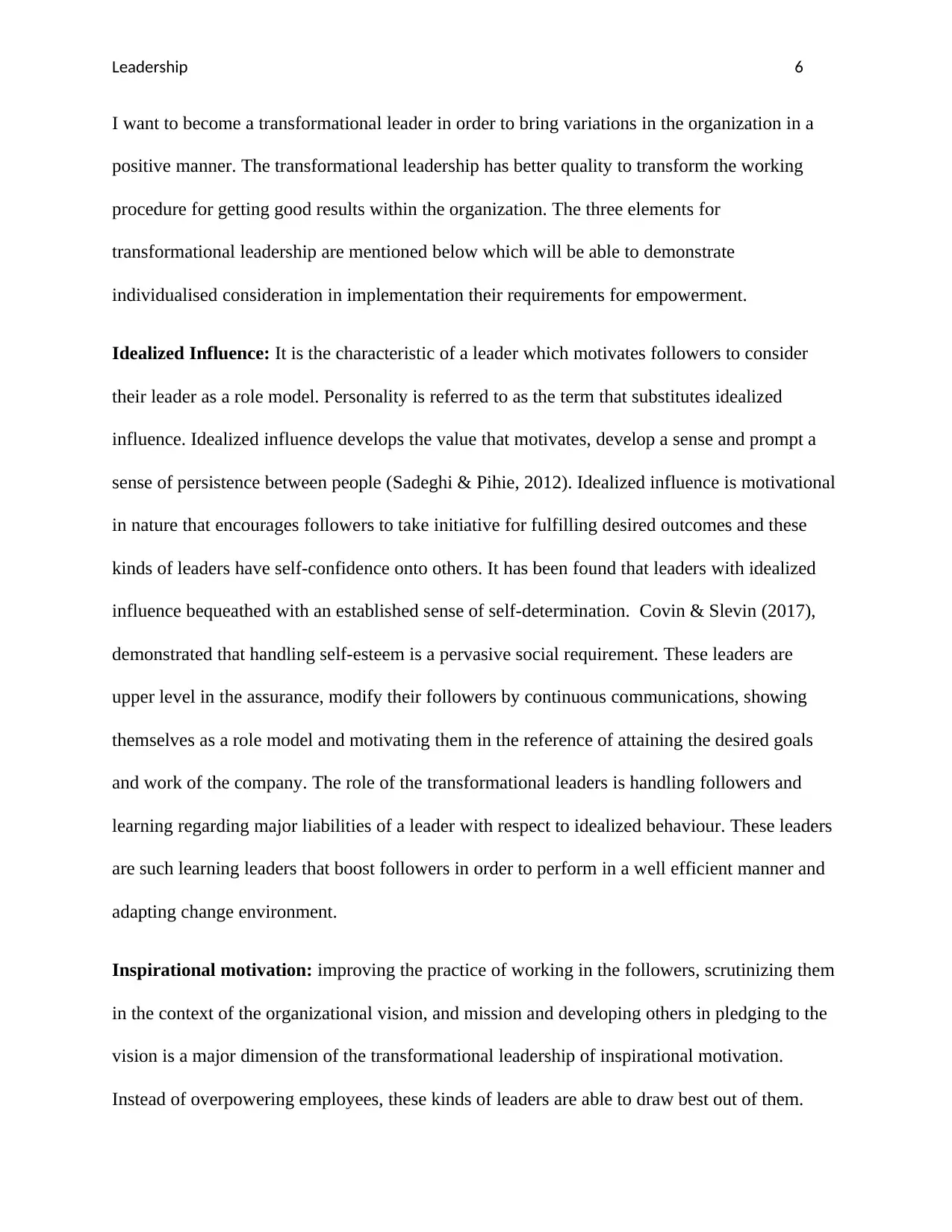
Leadership 6
I want to become a transformational leader in order to bring variations in the organization in a
positive manner. The transformational leadership has better quality to transform the working
procedure for getting good results within the organization. The three elements for
transformational leadership are mentioned below which will be able to demonstrate
individualised consideration in implementation their requirements for empowerment.
Idealized Influence: It is the characteristic of a leader which motivates followers to consider
their leader as a role model. Personality is referred to as the term that substitutes idealized
influence. Idealized influence develops the value that motivates, develop a sense and prompt a
sense of persistence between people (Sadeghi & Pihie, 2012). Idealized influence is motivational
in nature that encourages followers to take initiative for fulfilling desired outcomes and these
kinds of leaders have self-confidence onto others. It has been found that leaders with idealized
influence bequeathed with an established sense of self-determination. Covin & Slevin (2017),
demonstrated that handling self-esteem is a pervasive social requirement. These leaders are
upper level in the assurance, modify their followers by continuous communications, showing
themselves as a role model and motivating them in the reference of attaining the desired goals
and work of the company. The role of the transformational leaders is handling followers and
learning regarding major liabilities of a leader with respect to idealized behaviour. These leaders
are such learning leaders that boost followers in order to perform in a well efficient manner and
adapting change environment.
Inspirational motivation: improving the practice of working in the followers, scrutinizing them
in the context of the organizational vision, and mission and developing others in pledging to the
vision is a major dimension of the transformational leadership of inspirational motivation.
Instead of overpowering employees, these kinds of leaders are able to draw best out of them.
I want to become a transformational leader in order to bring variations in the organization in a
positive manner. The transformational leadership has better quality to transform the working
procedure for getting good results within the organization. The three elements for
transformational leadership are mentioned below which will be able to demonstrate
individualised consideration in implementation their requirements for empowerment.
Idealized Influence: It is the characteristic of a leader which motivates followers to consider
their leader as a role model. Personality is referred to as the term that substitutes idealized
influence. Idealized influence develops the value that motivates, develop a sense and prompt a
sense of persistence between people (Sadeghi & Pihie, 2012). Idealized influence is motivational
in nature that encourages followers to take initiative for fulfilling desired outcomes and these
kinds of leaders have self-confidence onto others. It has been found that leaders with idealized
influence bequeathed with an established sense of self-determination. Covin & Slevin (2017),
demonstrated that handling self-esteem is a pervasive social requirement. These leaders are
upper level in the assurance, modify their followers by continuous communications, showing
themselves as a role model and motivating them in the reference of attaining the desired goals
and work of the company. The role of the transformational leaders is handling followers and
learning regarding major liabilities of a leader with respect to idealized behaviour. These leaders
are such learning leaders that boost followers in order to perform in a well efficient manner and
adapting change environment.
Inspirational motivation: improving the practice of working in the followers, scrutinizing them
in the context of the organizational vision, and mission and developing others in pledging to the
vision is a major dimension of the transformational leadership of inspirational motivation.
Instead of overpowering employees, these kinds of leaders are able to draw best out of them.
⊘ This is a preview!⊘
Do you want full access?
Subscribe today to unlock all pages.

Trusted by 1+ million students worldwide
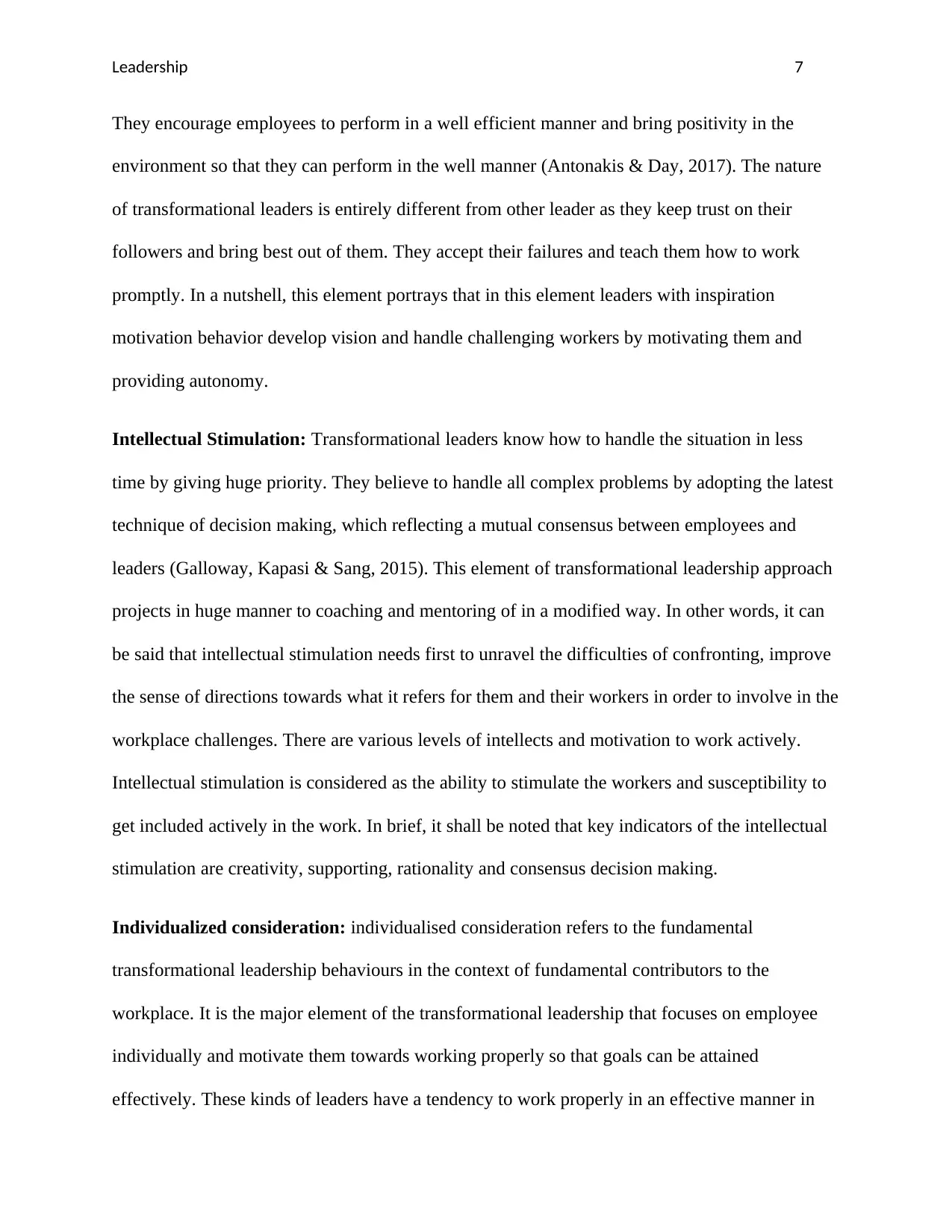
Leadership 7
They encourage employees to perform in a well efficient manner and bring positivity in the
environment so that they can perform in the well manner (Antonakis & Day, 2017). The nature
of transformational leaders is entirely different from other leader as they keep trust on their
followers and bring best out of them. They accept their failures and teach them how to work
promptly. In a nutshell, this element portrays that in this element leaders with inspiration
motivation behavior develop vision and handle challenging workers by motivating them and
providing autonomy.
Intellectual Stimulation: Transformational leaders know how to handle the situation in less
time by giving huge priority. They believe to handle all complex problems by adopting the latest
technique of decision making, which reflecting a mutual consensus between employees and
leaders (Galloway, Kapasi & Sang, 2015). This element of transformational leadership approach
projects in huge manner to coaching and mentoring of in a modified way. In other words, it can
be said that intellectual stimulation needs first to unravel the difficulties of confronting, improve
the sense of directions towards what it refers for them and their workers in order to involve in the
workplace challenges. There are various levels of intellects and motivation to work actively.
Intellectual stimulation is considered as the ability to stimulate the workers and susceptibility to
get included actively in the work. In brief, it shall be noted that key indicators of the intellectual
stimulation are creativity, supporting, rationality and consensus decision making.
Individualized consideration: individualised consideration refers to the fundamental
transformational leadership behaviours in the context of fundamental contributors to the
workplace. It is the major element of the transformational leadership that focuses on employee
individually and motivate them towards working properly so that goals can be attained
effectively. These kinds of leaders have a tendency to work properly in an effective manner in
They encourage employees to perform in a well efficient manner and bring positivity in the
environment so that they can perform in the well manner (Antonakis & Day, 2017). The nature
of transformational leaders is entirely different from other leader as they keep trust on their
followers and bring best out of them. They accept their failures and teach them how to work
promptly. In a nutshell, this element portrays that in this element leaders with inspiration
motivation behavior develop vision and handle challenging workers by motivating them and
providing autonomy.
Intellectual Stimulation: Transformational leaders know how to handle the situation in less
time by giving huge priority. They believe to handle all complex problems by adopting the latest
technique of decision making, which reflecting a mutual consensus between employees and
leaders (Galloway, Kapasi & Sang, 2015). This element of transformational leadership approach
projects in huge manner to coaching and mentoring of in a modified way. In other words, it can
be said that intellectual stimulation needs first to unravel the difficulties of confronting, improve
the sense of directions towards what it refers for them and their workers in order to involve in the
workplace challenges. There are various levels of intellects and motivation to work actively.
Intellectual stimulation is considered as the ability to stimulate the workers and susceptibility to
get included actively in the work. In brief, it shall be noted that key indicators of the intellectual
stimulation are creativity, supporting, rationality and consensus decision making.
Individualized consideration: individualised consideration refers to the fundamental
transformational leadership behaviours in the context of fundamental contributors to the
workplace. It is the major element of the transformational leadership that focuses on employee
individually and motivate them towards working properly so that goals can be attained
effectively. These kinds of leaders have a tendency to work properly in an effective manner in
Paraphrase This Document
Need a fresh take? Get an instant paraphrase of this document with our AI Paraphraser
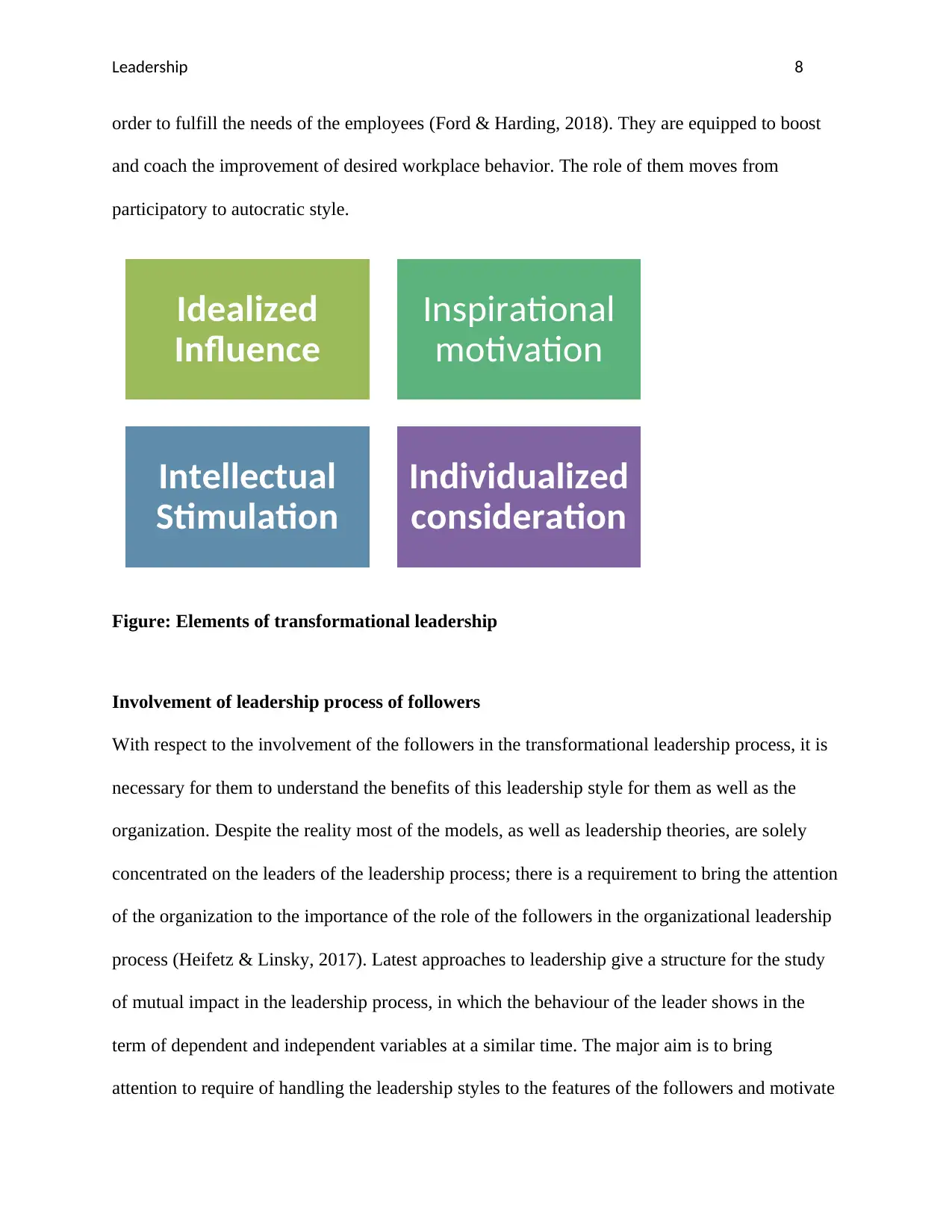
Leadership 8
order to fulfill the needs of the employees (Ford & Harding, 2018). They are equipped to boost
and coach the improvement of desired workplace behavior. The role of them moves from
participatory to autocratic style.
Figure: Elements of transformational leadership
Involvement of leadership process of followers
With respect to the involvement of the followers in the transformational leadership process, it is
necessary for them to understand the benefits of this leadership style for them as well as the
organization. Despite the reality most of the models, as well as leadership theories, are solely
concentrated on the leaders of the leadership process; there is a requirement to bring the attention
of the organization to the importance of the role of the followers in the organizational leadership
process (Heifetz & Linsky, 2017). Latest approaches to leadership give a structure for the study
of mutual impact in the leadership process, in which the behaviour of the leader shows in the
term of dependent and independent variables at a similar time. The major aim is to bring
attention to require of handling the leadership styles to the features of the followers and motivate
Idealized
Influence
Inspirational
motivation
Intellectual
Stimulation
Individualized
consideration
order to fulfill the needs of the employees (Ford & Harding, 2018). They are equipped to boost
and coach the improvement of desired workplace behavior. The role of them moves from
participatory to autocratic style.
Figure: Elements of transformational leadership
Involvement of leadership process of followers
With respect to the involvement of the followers in the transformational leadership process, it is
necessary for them to understand the benefits of this leadership style for them as well as the
organization. Despite the reality most of the models, as well as leadership theories, are solely
concentrated on the leaders of the leadership process; there is a requirement to bring the attention
of the organization to the importance of the role of the followers in the organizational leadership
process (Heifetz & Linsky, 2017). Latest approaches to leadership give a structure for the study
of mutual impact in the leadership process, in which the behaviour of the leader shows in the
term of dependent and independent variables at a similar time. The major aim is to bring
attention to require of handling the leadership styles to the features of the followers and motivate
Idealized
Influence
Inspirational
motivation
Intellectual
Stimulation
Individualized
consideration
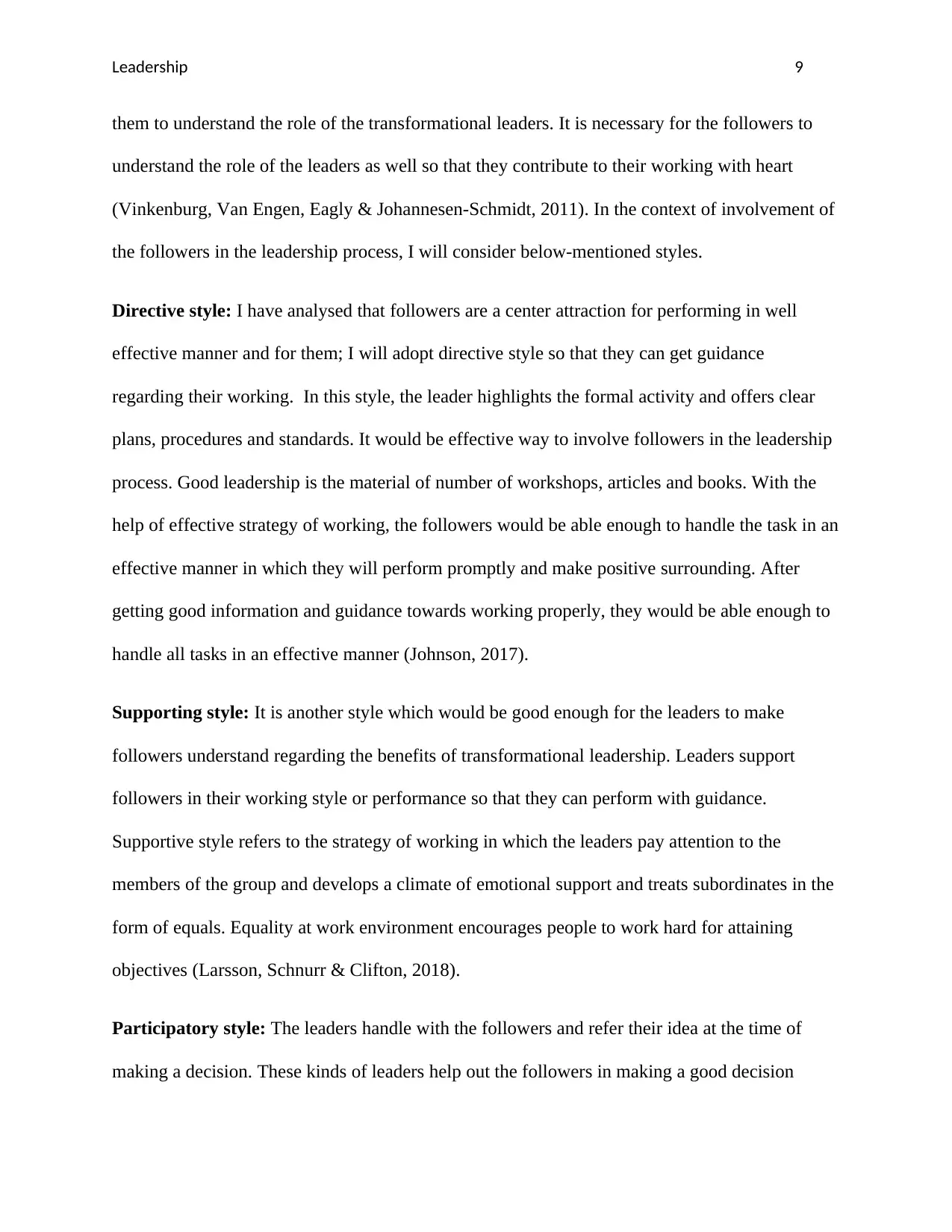
Leadership 9
them to understand the role of the transformational leaders. It is necessary for the followers to
understand the role of the leaders as well so that they contribute to their working with heart
(Vinkenburg, Van Engen, Eagly & Johannesen-Schmidt, 2011). In the context of involvement of
the followers in the leadership process, I will consider below-mentioned styles.
Directive style: I have analysed that followers are a center attraction for performing in well
effective manner and for them; I will adopt directive style so that they can get guidance
regarding their working. In this style, the leader highlights the formal activity and offers clear
plans, procedures and standards. It would be effective way to involve followers in the leadership
process. Good leadership is the material of number of workshops, articles and books. With the
help of effective strategy of working, the followers would be able enough to handle the task in an
effective manner in which they will perform promptly and make positive surrounding. After
getting good information and guidance towards working properly, they would be able enough to
handle all tasks in an effective manner (Johnson, 2017).
Supporting style: It is another style which would be good enough for the leaders to make
followers understand regarding the benefits of transformational leadership. Leaders support
followers in their working style or performance so that they can perform with guidance.
Supportive style refers to the strategy of working in which the leaders pay attention to the
members of the group and develops a climate of emotional support and treats subordinates in the
form of equals. Equality at work environment encourages people to work hard for attaining
objectives (Larsson, Schnurr & Clifton, 2018).
Participatory style: The leaders handle with the followers and refer their idea at the time of
making a decision. These kinds of leaders help out the followers in making a good decision
them to understand the role of the transformational leaders. It is necessary for the followers to
understand the role of the leaders as well so that they contribute to their working with heart
(Vinkenburg, Van Engen, Eagly & Johannesen-Schmidt, 2011). In the context of involvement of
the followers in the leadership process, I will consider below-mentioned styles.
Directive style: I have analysed that followers are a center attraction for performing in well
effective manner and for them; I will adopt directive style so that they can get guidance
regarding their working. In this style, the leader highlights the formal activity and offers clear
plans, procedures and standards. It would be effective way to involve followers in the leadership
process. Good leadership is the material of number of workshops, articles and books. With the
help of effective strategy of working, the followers would be able enough to handle the task in an
effective manner in which they will perform promptly and make positive surrounding. After
getting good information and guidance towards working properly, they would be able enough to
handle all tasks in an effective manner (Johnson, 2017).
Supporting style: It is another style which would be good enough for the leaders to make
followers understand regarding the benefits of transformational leadership. Leaders support
followers in their working style or performance so that they can perform with guidance.
Supportive style refers to the strategy of working in which the leaders pay attention to the
members of the group and develops a climate of emotional support and treats subordinates in the
form of equals. Equality at work environment encourages people to work hard for attaining
objectives (Larsson, Schnurr & Clifton, 2018).
Participatory style: The leaders handle with the followers and refer their idea at the time of
making a decision. These kinds of leaders help out the followers in making a good decision
⊘ This is a preview!⊘
Do you want full access?
Subscribe today to unlock all pages.

Trusted by 1+ million students worldwide
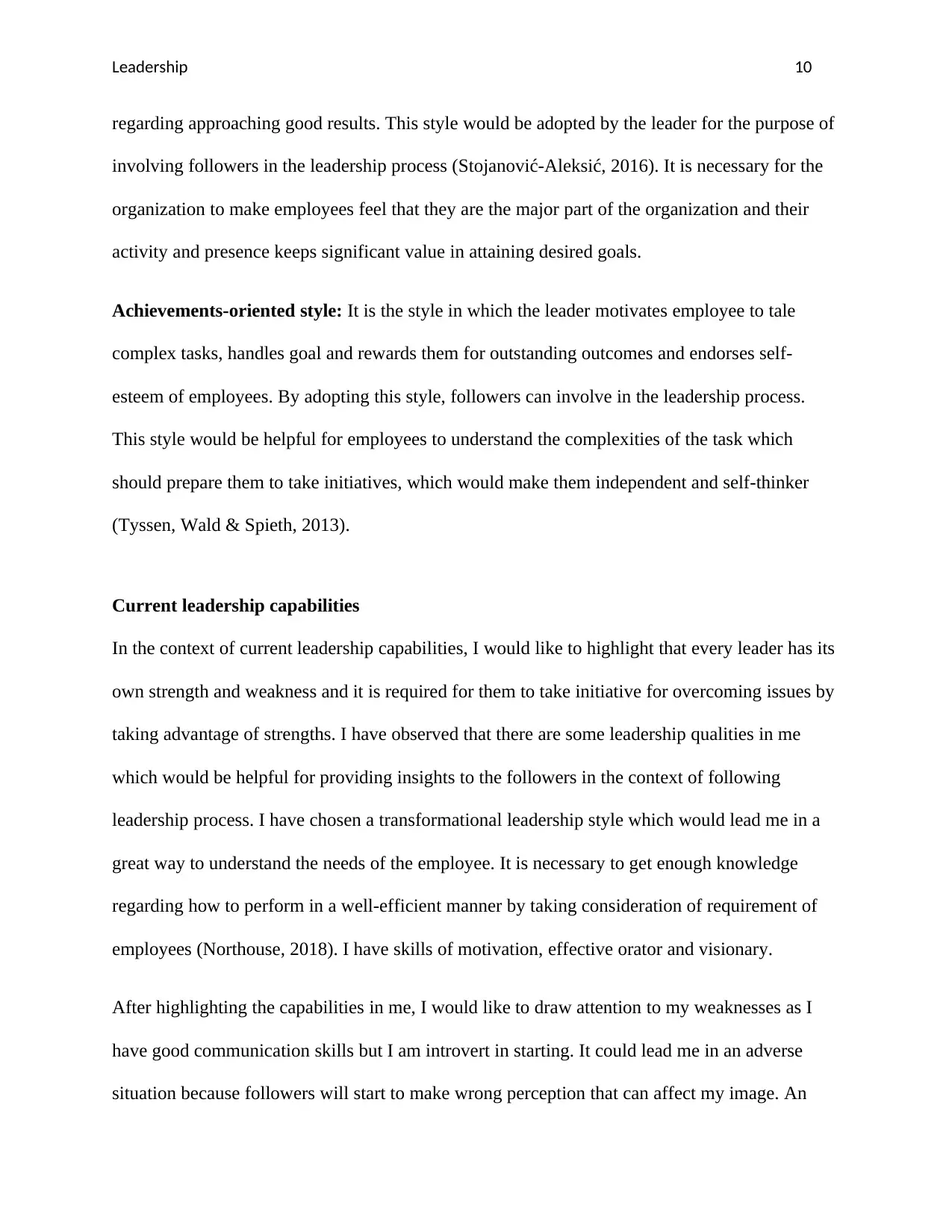
Leadership 10
regarding approaching good results. This style would be adopted by the leader for the purpose of
involving followers in the leadership process (Stojanović-Aleksić, 2016). It is necessary for the
organization to make employees feel that they are the major part of the organization and their
activity and presence keeps significant value in attaining desired goals.
Achievements-oriented style: It is the style in which the leader motivates employee to tale
complex tasks, handles goal and rewards them for outstanding outcomes and endorses self-
esteem of employees. By adopting this style, followers can involve in the leadership process.
This style would be helpful for employees to understand the complexities of the task which
should prepare them to take initiatives, which would make them independent and self-thinker
(Tyssen, Wald & Spieth, 2013).
Current leadership capabilities
In the context of current leadership capabilities, I would like to highlight that every leader has its
own strength and weakness and it is required for them to take initiative for overcoming issues by
taking advantage of strengths. I have observed that there are some leadership qualities in me
which would be helpful for providing insights to the followers in the context of following
leadership process. I have chosen a transformational leadership style which would lead me in a
great way to understand the needs of the employee. It is necessary to get enough knowledge
regarding how to perform in a well-efficient manner by taking consideration of requirement of
employees (Northouse, 2018). I have skills of motivation, effective orator and visionary.
After highlighting the capabilities in me, I would like to draw attention to my weaknesses as I
have good communication skills but I am introvert in starting. It could lead me in an adverse
situation because followers will start to make wrong perception that can affect my image. An
regarding approaching good results. This style would be adopted by the leader for the purpose of
involving followers in the leadership process (Stojanović-Aleksić, 2016). It is necessary for the
organization to make employees feel that they are the major part of the organization and their
activity and presence keeps significant value in attaining desired goals.
Achievements-oriented style: It is the style in which the leader motivates employee to tale
complex tasks, handles goal and rewards them for outstanding outcomes and endorses self-
esteem of employees. By adopting this style, followers can involve in the leadership process.
This style would be helpful for employees to understand the complexities of the task which
should prepare them to take initiatives, which would make them independent and self-thinker
(Tyssen, Wald & Spieth, 2013).
Current leadership capabilities
In the context of current leadership capabilities, I would like to highlight that every leader has its
own strength and weakness and it is required for them to take initiative for overcoming issues by
taking advantage of strengths. I have observed that there are some leadership qualities in me
which would be helpful for providing insights to the followers in the context of following
leadership process. I have chosen a transformational leadership style which would lead me in a
great way to understand the needs of the employee. It is necessary to get enough knowledge
regarding how to perform in a well-efficient manner by taking consideration of requirement of
employees (Northouse, 2018). I have skills of motivation, effective orator and visionary.
After highlighting the capabilities in me, I would like to draw attention to my weaknesses as I
have good communication skills but I am introvert in starting. It could lead me in an adverse
situation because followers will start to make wrong perception that can affect my image. An
Paraphrase This Document
Need a fresh take? Get an instant paraphrase of this document with our AI Paraphraser
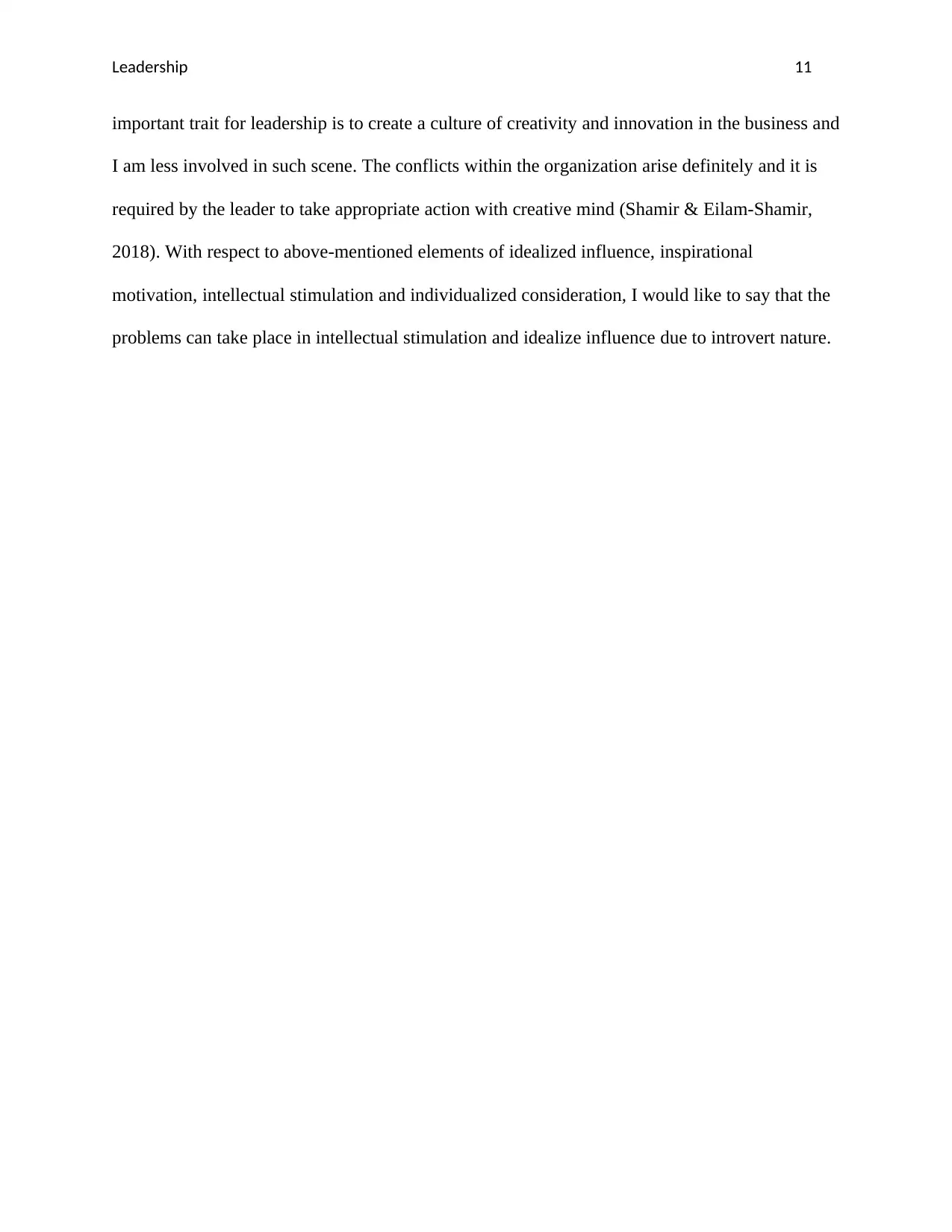
Leadership 11
important trait for leadership is to create a culture of creativity and innovation in the business and
I am less involved in such scene. The conflicts within the organization arise definitely and it is
required by the leader to take appropriate action with creative mind (Shamir & Eilam-Shamir,
2018). With respect to above-mentioned elements of idealized influence, inspirational
motivation, intellectual stimulation and individualized consideration, I would like to say that the
problems can take place in intellectual stimulation and idealize influence due to introvert nature.
important trait for leadership is to create a culture of creativity and innovation in the business and
I am less involved in such scene. The conflicts within the organization arise definitely and it is
required by the leader to take appropriate action with creative mind (Shamir & Eilam-Shamir,
2018). With respect to above-mentioned elements of idealized influence, inspirational
motivation, intellectual stimulation and individualized consideration, I would like to say that the
problems can take place in intellectual stimulation and idealize influence due to introvert nature.
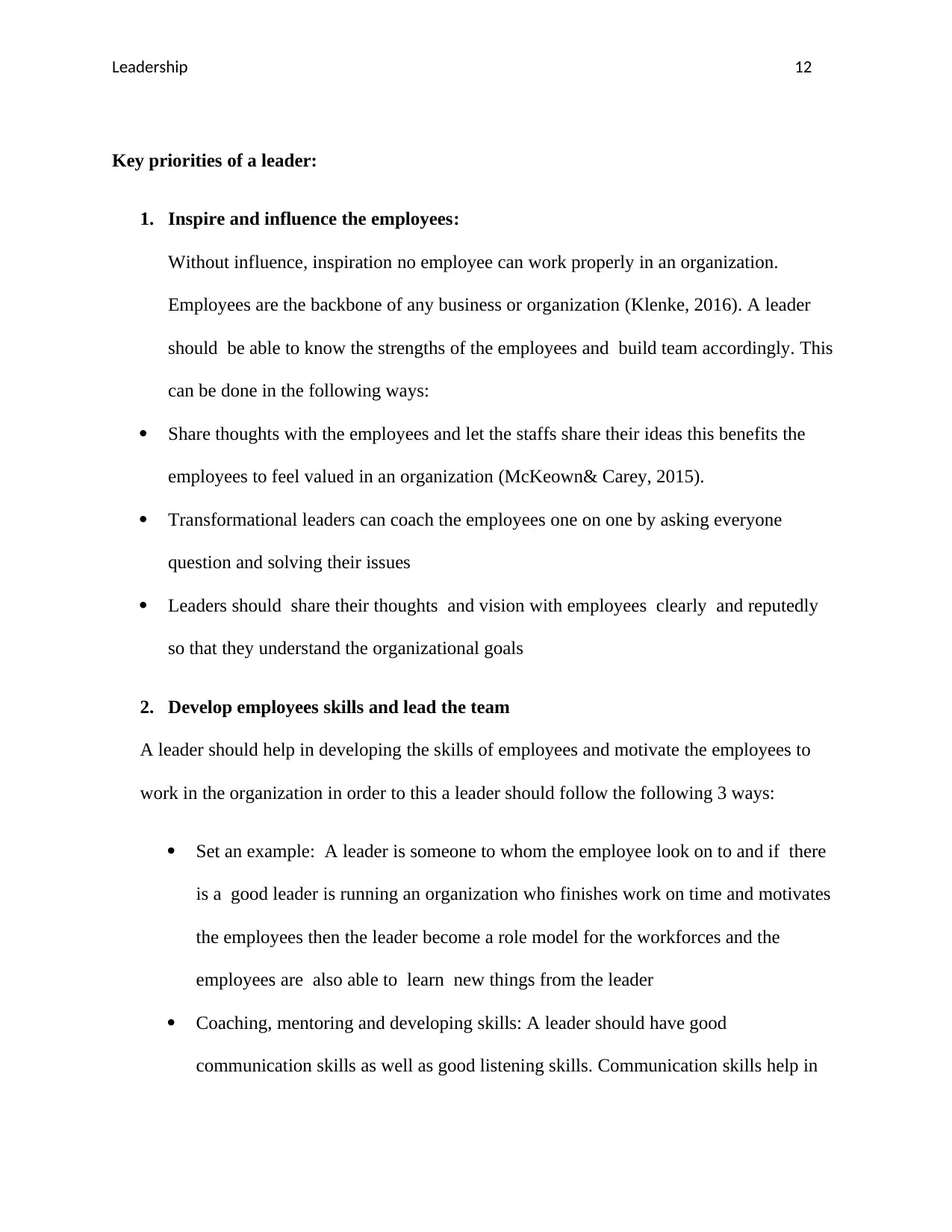
Leadership 12
Key priorities of a leader:
1. Inspire and influence the employees:
Without influence, inspiration no employee can work properly in an organization.
Employees are the backbone of any business or organization (Klenke, 2016). A leader
should be able to know the strengths of the employees and build team accordingly. This
can be done in the following ways:
Share thoughts with the employees and let the staffs share their ideas this benefits the
employees to feel valued in an organization (McKeown& Carey, 2015).
Transformational leaders can coach the employees one on one by asking everyone
question and solving their issues
Leaders should share their thoughts and vision with employees clearly and reputedly
so that they understand the organizational goals
2. Develop employees skills and lead the team
A leader should help in developing the skills of employees and motivate the employees to
work in the organization in order to this a leader should follow the following 3 ways:
Set an example: A leader is someone to whom the employee look on to and if there
is a good leader is running an organization who finishes work on time and motivates
the employees then the leader become a role model for the workforces and the
employees are also able to learn new things from the leader
Coaching, mentoring and developing skills: A leader should have good
communication skills as well as good listening skills. Communication skills help in
Key priorities of a leader:
1. Inspire and influence the employees:
Without influence, inspiration no employee can work properly in an organization.
Employees are the backbone of any business or organization (Klenke, 2016). A leader
should be able to know the strengths of the employees and build team accordingly. This
can be done in the following ways:
Share thoughts with the employees and let the staffs share their ideas this benefits the
employees to feel valued in an organization (McKeown& Carey, 2015).
Transformational leaders can coach the employees one on one by asking everyone
question and solving their issues
Leaders should share their thoughts and vision with employees clearly and reputedly
so that they understand the organizational goals
2. Develop employees skills and lead the team
A leader should help in developing the skills of employees and motivate the employees to
work in the organization in order to this a leader should follow the following 3 ways:
Set an example: A leader is someone to whom the employee look on to and if there
is a good leader is running an organization who finishes work on time and motivates
the employees then the leader become a role model for the workforces and the
employees are also able to learn new things from the leader
Coaching, mentoring and developing skills: A leader should have good
communication skills as well as good listening skills. Communication skills help in
⊘ This is a preview!⊘
Do you want full access?
Subscribe today to unlock all pages.

Trusted by 1+ million students worldwide
1 out of 18
Related Documents
Your All-in-One AI-Powered Toolkit for Academic Success.
+13062052269
info@desklib.com
Available 24*7 on WhatsApp / Email
![[object Object]](/_next/static/media/star-bottom.7253800d.svg)
Unlock your academic potential
Copyright © 2020–2025 A2Z Services. All Rights Reserved. Developed and managed by ZUCOL.





